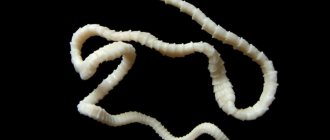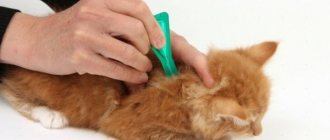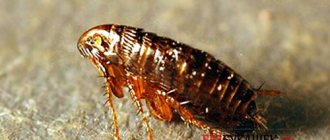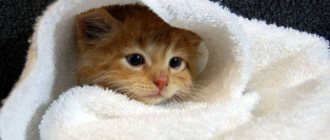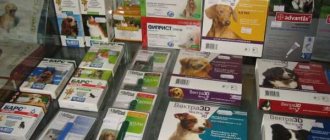Insecticides are dangerous to animal health. Therefore, when treating a cat with flea drops, there is a risk of poisoning. This is especially true for those owners who have several pets. After all, cats often lick each other and can accidentally swallow medicine. Let's find out what measures need to be taken to save animals in case of insecticide poisoning and whether it is possible to do without calling a veterinarian.
Causes of poisoning with flea drops
Most often, veterinarians indicate the following causes of poisoning in cats:
- Incorrect application of the product, namely smearing and rubbing concentrated solutions of insectoacaricides on parts of the cat’s body that are accessible to licking (belly, ears, inner thighs, tail root). The correct application of drops is pointwise in 1-2 zones along the spinal column, without rubbing. The drug spreads well and penetrates into the subcutaneous fat and hair follicles, from there it affects the tick and flea upon contact or bite.
- Treatment of weakened and sick animals, which is a complete contraindication for such manipulations. Since a small part of the active substances in flea drops still penetrates the bloodstream, a toxic effect on the cat’s liver and kidneys cannot be ruled out.
- Exceeding the dosage most often occurs when determining the pet’s weight “by eye”. Double or higher concentrations of the drug are considered dangerous. Therefore, animals need to be weighed periodically.
- The cat was washed a day after treatment, and she licked off the remaining flea drops. Poisoning occurs due to the fact that the flea remedy, which is not absorbed, is washed out over the entire surface of the cat’s fur, from where she licks it off.
- Use of canine products. Many drugs that are intended for dogs and cats are produced under the same name, but they often have different compositions. Due to cats' intolerance to certain insecticides, to which dogs do not have a similar reaction, severe poisoning may develop, even leading to death. Therefore, it is unacceptable to buy one product for different types of animals. If you need to save money, you should study the instructions for the drugs or check the name with your veterinarian.
- Handling kittens that are breastfed can be dangerous for the mother cat, as her constant licking of her babies may cause her to ingest chemicals from their fur.
- Individual intolerance to certain substances, which is typical for cats of decorative breeds. It is worth checking with the breeder about this when purchasing purebred kittens.
How to help your pet
Having noticed alarming symptoms, you need to try to alleviate the condition of a cat poisoned by flea drops as much as possible. Ideally, take the animal to the veterinarian and place it in the hands of a professional. However, this is not always possible, and it’s a shame to look at a cat. What to do in this case?
You can give the animal rice water. It is prepared by pouring one and a half tablespoons of cereal with half a liter of water and boiling over low heat for about forty minutes. The cooled and strained liquid is offered to the cat. Since he is constantly thirsty, most likely he will not refuse the medicine. Otherwise, the broth is poured inside the cat using a syringe.
Among medications for poisoning with flea drops, Smecta is used. Half a sachet of this drug is diluted with two tablespoons of water and poured into the mouth or offered to the animal as a drink. The danger to a cat can be significantly reduced by allowing the animal to lick half a tablet of regular activated carbon, crushed and dissolved in water.
It will draw out all toxins from the body. No-Shpa will help relieve the condition caused by the drops. The dose of this drug for an adult cat is also 0.5 tablets. But the intestinal microflora is perfectly restored by the prebiotic for animals “Vetelakt”. The specifics of its use are described in the attached instructions.
A cat that has been poisoned by flea drops should drink more. You can add a little potassium permanganate to the water if the incident occurred recently. Fatty, salty, sweet foods are contraindicated for the animal during this period. Most likely, the cat himself will refuse such food, because his appetite is practically zero.
Poisoning with FOS substances and carbamates
Organophosphates (diazinon, tetrachlorvinphos) and carbamates (propoxur) are considered obsolete and toxic agents for the control of insects and ticks in cats.
Since 2004, they have been used mainly in agriculture. However, some modern pharmaceutical companies continue to produce cat drops and flea collars with these substances due to their proven effectiveness and good sales. Examples:
- flea drops “Flea Drops” from Beaphar with the active ingredient diazinon (which are no longer sold in Russia, but are available in other countries);
- insecticidal drops “Best friend Ectostop” on diazinon;
- anti-parasite collars from Hartz (tetrachlorvinphos).
Several years ago in the Russian Federation, the drug “Dana” was produced with diazinon, but today the API-SAN company has changed the composition of flea drops (fipronil + auxiliary components).
Carbamates (propoxur) are present in some flea collars for cats from the Bolfo brand, and poisoning can occur if the cat licks or chews the accessory.
Clinical symptoms
If it happens that the cat licked the flea drops with diazinon, then clinically this is expressed by the following signs:
- excessive salivation from the mouth (a characteristic sign);
- lethargy, apathy;
- frequent urge to vomit (expressed as smacking and licking);
- loose stools;
- complete lack of appetite;
- muscle weakness and convulsive manifestations;
- rapid or, conversely, weakened heartbeat (depending on the dose);
- shortness of breath, rapid breathing with an open mouth;
- constant “small” trips and thirst.
A local allergic reaction is expressed in redness of the area where drops are applied, development of irritation, itching, and scratching.
Treatment
In such cases, the first thing to do is to prevent further absorption of toxins from the skin by washing off the product using a cleansing shampoo with a strong degreasing effect.
Next, it is recommended to rinse the cat’s mouth and stomach and induce vomiting by injecting a large amount of water. After washing, sorbents (activated carbon, Smecta, Enterosgel) are introduced.
If convulsions or muscle tremors appear, you should immediately take the cat to the veterinarian, he will administer intravenous anticonvulsants to reduce agitation and other necessary drugs (Atropine, Diazepam), prescribe infusion therapy and a therapeutic diet.
Actions in case of poisoning
The most important thing you can do is contact your veterinarian. And the sooner the better! If you do not have the opportunity to immediately rush to the hospital with the injured cat, use the tips below:
Help with diarrhea:
- rice broth (cook 1.5 teaspoons of rice in 0.5 liters of water for 40 minutes over low heat, then cool the broth and strain);
- “Smecta” (feed the animal from a syringe, dilute 0.5 sachets of the drug in 20 ml of warm water);
As an adsorbent (a substance that removes all the nasty stuff from the stomach) use:
- “Enterosgel” (give 1 cm of paste to the animal to eat);
- activated carbon (crush in water and give from a syringe, at the rate of 1 tablet per 1 kg of pet’s body weight);
- you can make a solution of potassium permanganate for drinking or an enema with potassium permanganate (a very light solution);
As a pain reliever you can give:
- “No-shpu” (0.5 crushed tablets);
- "Baralgin" (0.6 crushed tablets).
In addition, veterinarians recommend:
- as a means of restoring intestinal microflora, use Vetelakt;
- try to follow a diet: nothing fatty, salty, give plenty of drink;
- It is best to bathe the animal with zoo shampoo to wash away any residual drops.
Poisoning with pyrethrins and pyrethroids
Pyrethrins are insecticides of plant origin, which are obtained from certain types of plants (Dalmatian chamomile, chrysanthemum, tansy). In veterinary medicine, permethrin is actively used for cats (at 0.5-1% concentration in anti-flea shampoos, collars, drops, but in other proportions it is considered poison).
This is explained by the fact that in a cat’s body, permethrin does not break down into harmless compounds (as it does in dogs) and exhibits a toxic effect on the nervous system, which leads to prolonged convulsions and death.
This is why owners should be aware that permethrin dog drops should not be used on cats, as it can kill them.
Attention! If a cat licks flea drops containing permethrin applied to a dog upon contact, this will also cause poisoning. If a cat and a dog live together in the house, then it is better to buy insectoacaricidal products with other components.
Examples of existing products for cats with permethrin (their use is permissible only if the instructions are strictly followed):
- drops on the withers “Clandestine for cats” (1% permethrin);
- “Clandestine” universal powder (0.4% permethrin);
- spray "Clandestine" for cats and dogs (0.35% permethrin);
- anti-parasitic shampoos of the “Clandestine” brand (0.4% permethrin);
- anti-flea collars “Clandestine maximum” for cats (1% permethrin);
- “Pchelodar” – universal shampoo against fleas and ticks (0.25% permethrin);
- insecticidal shampoo for cats and dogs “Fitoelita” (0.3% permethrin);
- flea shampoo “Lapushka” (0.4% permethrin).
Pyrethroids are synthetic analogues of pyrethrins. Deltamethrin and etofenprox are used for domestic cats. Examples of drugs:
- Lugovoy shampoo for cats and dogs (deltamethrin 0.01%);
- drops for fleas in cats brand “Rolf Club 3D” (etofenprox 15%);
- butox 50 concentrate for preparing a solution (deltamethrin 5%).
Recently, due to frequent cases of poisoning in cats by these substances, many manufacturers of veterinary insecticides are discontinuing the production of certain drugs or replacing the formulation.
Symptoms
So, what happens if a cat licks flea drops that contain pyrethrins and pyrethroids:
- Half of the cats experience overexcitation, which is expressed in prolonged convulsions and twitching of the limbs;
- trembling;
- saliva is produced profusely;
- there is a loss of orientation in space;
- body temperature rises;
- pupils dilate;
- temporary hypersensitivity appears;
- coordination of movements is impaired;
- heart rate increases;
- gagging is observed;
- lethargic sleep may occur.
Therapy
Pyrethrins have no antidotes, so treatment is aimed at removing toxins from the cat's body.
If the poison has entered the digestive system, then you need to start with the administration of emetics or gastric lavage. At home, you should pour warm water into the cat’s mouth to induce vomiting, then give adsorbents (Smecta, Enterosgel).
If pyrethroids are ingested externally in a toxic dose (when treating a cat with dog drops), you need to wash the animal several times with regular shampoo and then feed it with adsorbents.
If a cat has licked off flea drops and has convulsive reactions, you should immediately go to the veterinarian, he will provide first aid, prescribe appropriate treatment, or leave the animal in a hospital under his supervision.
As a rule, cats recover in 3-5 days if first aid is provided to them in a timely and competent manner.
Removing fleas from older kittens
How to get rid of fleas in a kitten that has already grown up and is not attached to its mother? There are many drugs available in pharmacies for ridding animals of insects, but you should only purchase those that are intended specifically for cats. First of all, these are various shampoos:
- Mr. Kiss;
- "Clandestine Junior";
- "Gamma for kittens"
- "Phytoelite";
- "Doctor ZOO"
The last two products contain only natural ingredients and can be used for very young kittens.
How to rid a kitten of fleas using shampoo? The procedure is carried out as follows:
- A drop of shampoo is diluted in one and a half glasses of warm water.
- The baby's fur, moistened with water, is carefully lathered with the solution, making sure that it does not get into the eyes and ears.
- Leave the solution on the kitten's fur for a few minutes and then rinse with warm water.
- The washed kitten is wrapped in a warm soft towel or dried with a hairdryer if it reacts normally to it.
To prevent your baby from catching a cold, you should not walk him or leave him in a draft on this day.
The washing procedure is always some stress for the animal, so you can try to remove fleas from a kitten using various veterinary preparations for insect control, produced in the form of drops and sprays. There are several types:
- "Frontline" (in the form of drops or spray);
- "Bars" (drops and spray);
- “Clandestine” (drops and spray);
- "Fipronil" (drops and spray);
- "Advantage" drops;
- Selamectin drops;
- Beafar drops.
These products can be used starting from 2-3 months of age. Before using them, a susceptibility test must be performed. If, a day after trial use on a small area, no negative reactions (itching, redness) appear, you can treat the entire pet’s fur, following the enclosed instructions.
Drops are applied behind the ears, on the back of the head and back, from where they reach the entire skin. Their validity period is from 4 to 8 weeks, they destroy existing fleas and repel new ones. They can only be used on kittens over 2 months old.
Flea spray is more convenient; it is applied first to the hands, which are then used to smooth the kitten’s fur. This should be done with gloves.
Knowing how to remove fleas from a kitten at home, the owner of the baby not only takes care of its protection from infectious diseases, but also helps the pet grow up healthy and cheerful.
Poisoning with vegetable oil extracts
Some cat owners prefer to buy biological products for fleas, created on the basis of extracts of various plants (neem, mint, geranium, citronella, cloves, rosemary, tea tree, cinnamon). Such products effectively repel insects, but have virtually no effect on ticks.
Biological products are an excellent addition to classic insectoacaricides and can be the main method of protection for weakened, pregnant, lactating cats, as well as small kittens.
Examples of herbal drops on the withers:
- trademark GreenFort NEO (Ekoprom);
- a series of economical preparations Chistotel Bio (Ecoprom);
- line of VETO Pure Beaphar BIO products against fleas, ticks and mosquitoes with margosa extract;
- BIO series for cats against external parasites GAMMA;
- Good Dog Antiparasitic BIO drops;
- Natura Delix Bio Drops;
- ECO ZOOLEKAR BIO drops;
- Bio-drops AVZ “4 with a tail”;
- Drops "Rainbow BIO";
- Bio-Drops repellent Ms.Kiss;
- Flea remedy "BioVax-BIO".
However, a cat can also be poisoned by plant extracts if it ingests a large dose of the drug while licking its kittens or itself. For the first alarming symptoms to appear, a long-term interaction between the animal and the biological product is necessary (frequent treatments, a large number of kittens sprayed with the biological product, or a group of several cats that live in the same territory and lick each other).
There are pets with increased sensitivity to certain odors and extracts (congenital allergies), in which the first symptoms of poisoning may appear after a single treatment.
Typically, the problem of overdose with plant extracts is rare, and biological products have a short shelf life. Therefore, owners of city cats who take their pets out into nature try to apply drops or spray more often to avoid flea attacks.
You can also often read advice to cat owners on pet forums: “Treat your cats with biodrops every week or apply a herbal spray to their paws every day before walking outside.” Such advice contradicts the instructions for biological products, which leads to poisoning with plant extracts.
Signs of poisoning
If a cat manages to ingest plant drops against fleas, then after 30-50 minutes the following symptoms of poisoning will appear:
- excessive salivation (hypersalivation);
- refusal to eat for a day or more;
- lacrimation;
- vomit;
- muscle contractions, tremors;
- decreased body temperature (below 37.5);
- lethargy and apathy.
Deaths are quite rare with such poisonings, but are not excluded with prolonged low body temperature and decreased blood pressure.
Treatment methods
Treatment consists of eliminating severe symptoms and removing any remaining product from the cat’s fur. Namely:
- gastric lavage, stimulation of vomiting (pour in liquid, press on the root of the tongue with a spoon);
- soldering of adsorbents (activated carbon, Smecta, Enterosgel);
- drip infusion of nutrient solutions into a vein to prevent dehydration;
- for muscle twitching, Diazepam (a sedative) is administered;
- bathing in soapy water using a cleansing shampoo (to wash the drug off the skin and coat).
With this treatment, the animal will recover within 1-2 days.
Important! If a cat has an unusual reaction to a biological product, it is worth studying its composition and not buying analogues in the future.
First aid for kitten poisoning
What to do first if a kitten is poisoned? Regardless of whether you go to the vet or not, give your kitten first aid immediately.
Stop the animal's contact with the poison. If the kitten has inhaled harmful fumes, take him out into the fresh air. If he has soiled fur or has suffered from improper use of flea treatment, wash him with soap or baby shampoo.
Induce vomiting if the cat is poisoned by eating the poison. You can do this in one of the following ways.
- 3% hydrogen peroxide solution at the rate of half a teaspoon per 1 kg of weight. Repeat up to three times after ten minutes.
- Salt solution: dilute one teaspoon in half a glass of water. It is enough to pour 10–20 ml of solution into the kitten.
- The potassium permanganate solution is slightly pink in color.
- Place a few baking soda crystals on the root of your tongue.
- Ipecac syrup: one teaspoon per 5 kg of weight.
Solutions are poured into the mouth from a teaspoon or syringe without a needle.
You should not induce vomiting in a kitten in the following cases.
- If he's already vomited. It is also useless to induce vomiting if more than 2 hours have passed since the poison was eaten - it has already left the stomach.
- If the animal is inhibited or in a coma. In this condition, there is a high probability of disruption of the gag reflex, and the kitten may choke on vomit.
- In case of poisoning with alkalis, acids, detergents, petroleum products.
Don't despair if you are unable to induce vomiting in your kitten. What to do next?
In case of food poisoning, give the kitten adsorbents and coating substances to slow down the absorption of the poison. Activated carbon, crushed and diluted in water, Polysorb, Enterosgel or other adsorbents.
Flaxseed decoction, milk, egg white solution (with water 1:1), liquid starch paste or other mucous decoction.
What to do if a kitten is poisoned and professional veterinary care is unavailable for some reason? In this case, it is necessary to accurately determine, if not the poison itself, then the nature of its effect on the body.
Allergy to toxins
If you apply flea drops correctly to the withers, the cat should not lick them off. The situation is much more complicated if the kitten is also treated with a toxic agent. Then the cat can become poisoned by licking its cubs. If there is only one kitten, then there is no need to worry too much, but if there are several kittens, you need to think through safety measures in advance.
It is better to protect the animals from each other for a couple of days. If the drug is licked by a small pet, the poison can act on it several times more powerfully. In addition, it is important to note that small kittens can grab each other by the neck while playing and thus ingest toxins.
Allergic reactions to flea drops for cats are extremely rare. But if your pet shows obvious allergy symptoms after applying the drug, and they do not go away within 1-2 days, you should urgently seek help from a veterinarian.
If you correctly apply drops to the withers against fleas, the cat should not lick them off
Dangerous symptoms include:
- itching at the site of application of the drug;
- hair loss;
- dermatitis.
A person also needs to be extremely careful when applying the drug. It is better to use gloves, and after the procedure, wash your hands thoroughly with soap. It is also recommended not to handle the animal for several days. Toxins can remain on the pet's skin, so upon contact with it, the poison can cause allergies in the owner.
But drops for cats have little toxicity for the animals themselves; such drugs act much more aggressively on fleas. Some parasites die immediately after applying the drug. This often happens when an insect gets into the area of the skin where the drops were applied. Other parasites try to escape from their host as soon as they smell an unbearable smell.
>Flea drops for cats can be dangerous (video)

